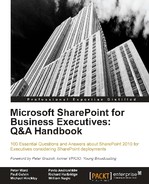A: SharePoint Online is a subscription-based service that provides customers with an enterprise-grade solution for creating sites to share documents and information with colleagues and customers. SharePoint Online is one of the several cloud services offered as part of Microsoft Office 365, Microsoft's premier SaaS offering.
Office 365 is also a subscription-based service that combines Exchange Online, Lync Online, SharePoint Online, and Office Professional into a cloud-based package for end users. With Office 365, users can access familiar Microsoft Office applications from anywhere, while the backend infrastructure is fully hosted, managed, and guaranteed by Microsoft.
While there are many benefits, you should ask yourself the following questions:
- Office 365 includes services other than SharePoint as part of its package. Does my organization need these additional services?
- Will Office 365 actually cost my organization less than running SharePoint on-premise?
- Office 365 does have feature and functionality limitations. Is this a deal-breaker for my organization?
Note
SharePoint Online, Exchange Online, Lync Online, and Office Professional Plus can also be purchased individually as standalone service plans. For additional information, refer to http://www.microsoft.com/en-us/office365/online-services.aspx#fbid=wv13IzdlRfL.
Office 365 has two top-level offerings: Standard and Dedicated. These two offerings are intended for different size organizations and have their own individual characteristics.
Office 365 Dedicated is targeted at enterprises that do not wish to be hosted on a multi-tenant environment. This offering enables more flexibility with deployments such as farm-based solution packages and support for third-party vendor add-ons. Please note that Microsoft only offers Office 365 Dedicated to customers with more than 20,000 users.
The Office 365 Standard offering is intended for small and medium-size organizations. While plans are always subject to change, the current Office 365 plans are: Office 365 for small businesses and professionals (Plan P), Office 365 for midsize businesses and enterprises (Plans E1, E2, E3, and E4), Office 365 for education, and Kiosk plans (Plan K).
Designated as Plan P, this SharePoint offering emphasizes content sharing rather than collaboration. Plan P is intended for a small number of users, up to 50. Plan highlights include basic online document viewing, editing, and mobile access using Office Web Apps, e-mail and calendaring with Exchange Online, basic public SharePoint site and content sharing with SharePoint Online, instant messaging with Lync Online, antivirus and anti-spam filtering with Forefront Online, and so on. Please note that this plan does not include Office Professional Plus, the capability of Active Directory integration, e-mail archiving, or any live customer support.
The Enterprise Plans are progressively more expensive than Plan P, but include more options; their features are generally cumulative.
- The E1 plan adds advanced administration capabilities, Active Directory integration, 24/7 support, and license rights to access on-premise deployments of Exchange, SharePoint, and Lync Server
- The E2 plan adds the ability to view, edit, and share content created in Word, Excel, PowerPoint, and OneNote desktop applications online with Office Web Apps
- The E3 plan adds Office Professional Plus, Visio Services, Access Services, rich forms for SharePoint Online, advanced archive capabilities, unlimited e-mail storage, and hosted voicemail
- The E4 plan adds enterprise voice capabilities to replace or enhance a PBX with Lync Server on-premise
The Microsoft Office 365 for Education plan is similar to the E3 plan for midsize businesses and enterprises.
The Kiosk Plans are designed for "kiosk" workers, who typically share terminals with other workers and only spend approximately 5-10 percent of their day sending e-mail or accessing company information. Typical examples of such workers include retail associates, manufacturing workers, and mail couriers. They have never had access to enterprise e-mail or collaboration platforms, so these plans are a good way to potentially improve productivity by introducing a common platform for light communication and collaboration.
- The K1 plan introduces e-mail, access to a company portal, and the ability to view Office documents
- The K2 plan adds Office Web Apps editing capabilities
